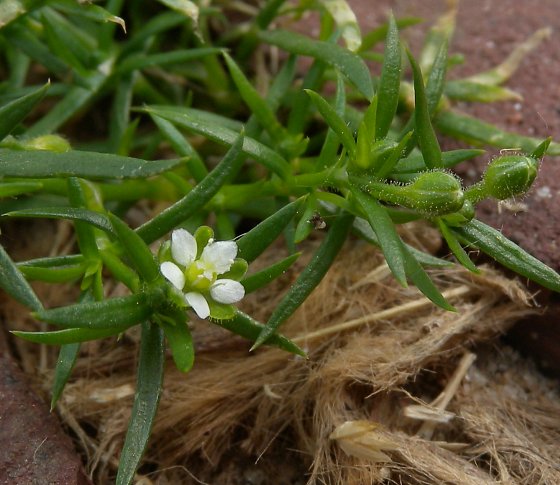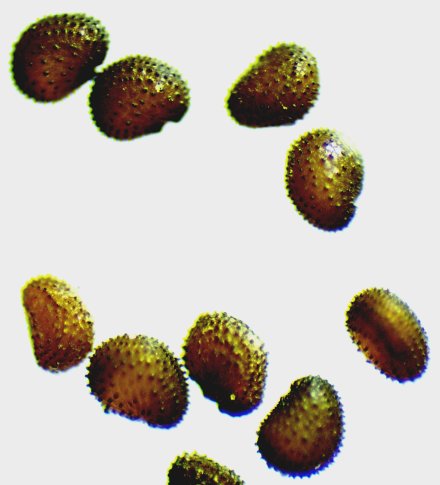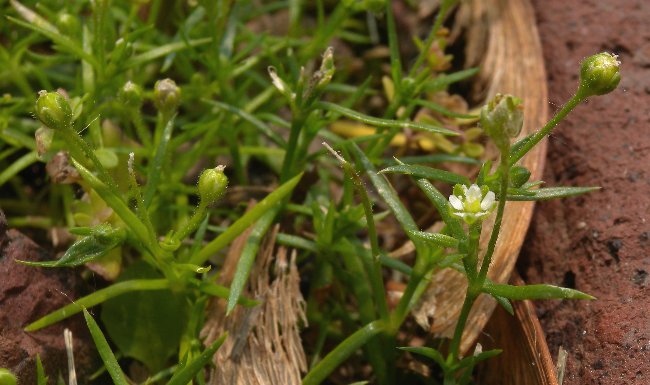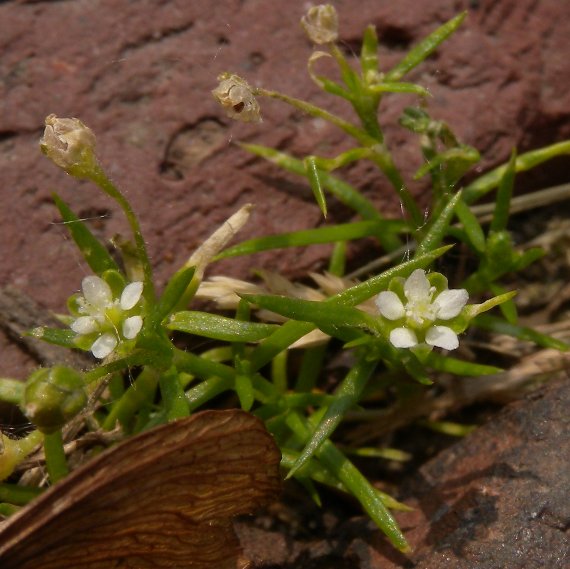Japanese
Pearlwort
Sagina japonica
Pink family (Caryophyllaceae)
Sagina japonica
Pink family (Caryophyllaceae)
Description:
This plant is a winter or spring annual that is 1–6" long and usually
unbranched; its leafy stems are erect, ascending, or sprawling.
Individual stems are light to medium green, terete, and mostly
hairless, except
above, where they may be glandular-pubescent. Pairs of opposite leaves
that are joined together at the base (connate) occur along the entire
length of the stems. Individual leaves are 1–2 mm. across and up
to 18 mm. (¾") long; they are medium green, hairless, linear in shape,
and
slightly succulent, tapering to acute tips. The stems terminate in
solitary flowers; solitary flowers also develop from the axils of upper
leaves. The pedicels (stalklets) of these flowers are light to medium
green, terete, glandular-pubescent, and 2–18 mm. long.

Each flower is about 3 mm. across, consisting of 5 white petals, 5 green sepals, 5 stamens with white anthers, and a light green pistil. Individual petals are elliptic in shape and narrowly tapered at the base. The sepals are ovate-oblong in shape with blunt tips, and glandular-pubescent on their exterior sides. The petals are the same length or slightly shorter than the sepals. The blooming period occurs from late spring to mid-summer, lasting about 1 month. Afterwards, the flowers are replaced by seed capsules. Mature capsules are about 3 mm. long, light brown, ovoid in shape, and flimsy-walled; the mature capsules have 5 sections that are joined together, but they are open at their apices. Each capsule contains several tiny seeds. Individual seeds are 0.3–0.5 mm. long, kidney-shaped (reniform), and dark brown; their surfaces have abundant black tubercles. These seeds are small enough to be blown about by the wind. The root system is shallow and fibrous overall, although it may have a short slender taproot. This plant reproduces by reseeding itself. Colonies of plants are often formed at favorable sites.

Cultivation: The preference is full or partial sun, moist conditions, and cool temperatures. The soil should be rocky, gravelly, sandy, or occur in cracks of pavement or bricks in areas where competition from other plants is reduced. Individual plants tend to be shorter, but flower more abundantly, in sunnier areas, as compared to shady areas. Once the summer weather becomes hot and dry, this plant dies down.
Range & Habitat: Japanese Pearlwort (Sagina japonica) is an introduced plant that is rare in Illinois, occurring in only 2 counties (Sangamon and Champaign counties); see Distribution Map. It is more common in northeastern USA, where it is also introduced. Japanese Pearlwort is native to east Asia. Habitats include cracks in patios, cracks in brick sidewalks, edges of gravelly driveways, and either sandy or gravelly waste areas. Disturbed areas are strongly preferred.

Faunal Associations: Information about floral-faunal relationships for this plant is very limited. Probably flies and small bees visit and cross-pollinate the flowers, where both nectar and pollen are available. Like many other members of the Pink family (Caryophyllaceae), the foliage of Pearlworts (Sagina spp.) is eaten by the Pale Tortoise Beetle (Cassida flaveola). Various animals and people probably spread the tiny seeds to new locations when they walk through areas where this plant occurs.
Photographic Location: A cracks of a brick sidewalk in Urbana, Illinois.

Comments: There are several species of Pearlworts (Sagina spp.) in Illinois, both native and non-native. None of them are very common within the state. Japanese Pearlwort (Sagina japonica) can be distinguished from other Pearlworts by the shape of its flower petals (elliptic in shape and tapering at the base), the presence of 5 petals and sepals on its flowers, the glandular pubescence of its pedicels and sepals, and its dark strongly tuberculate seeds. Other Pearlwort species differ from Japanese Pearlwort in one or more of the following characteristics: 1) they have differently shaped flower petals or none at all, 2) they have only 4 petals and sepals on their flowers, 3) their seeds are less tuberculate and/or lighter in color, and 4) their pedicels and sepals are either hairless or pubescent with non-glandular hairs.

Each flower is about 3 mm. across, consisting of 5 white petals, 5 green sepals, 5 stamens with white anthers, and a light green pistil. Individual petals are elliptic in shape and narrowly tapered at the base. The sepals are ovate-oblong in shape with blunt tips, and glandular-pubescent on their exterior sides. The petals are the same length or slightly shorter than the sepals. The blooming period occurs from late spring to mid-summer, lasting about 1 month. Afterwards, the flowers are replaced by seed capsules. Mature capsules are about 3 mm. long, light brown, ovoid in shape, and flimsy-walled; the mature capsules have 5 sections that are joined together, but they are open at their apices. Each capsule contains several tiny seeds. Individual seeds are 0.3–0.5 mm. long, kidney-shaped (reniform), and dark brown; their surfaces have abundant black tubercles. These seeds are small enough to be blown about by the wind. The root system is shallow and fibrous overall, although it may have a short slender taproot. This plant reproduces by reseeding itself. Colonies of plants are often formed at favorable sites.

Cultivation: The preference is full or partial sun, moist conditions, and cool temperatures. The soil should be rocky, gravelly, sandy, or occur in cracks of pavement or bricks in areas where competition from other plants is reduced. Individual plants tend to be shorter, but flower more abundantly, in sunnier areas, as compared to shady areas. Once the summer weather becomes hot and dry, this plant dies down.
Range & Habitat: Japanese Pearlwort (Sagina japonica) is an introduced plant that is rare in Illinois, occurring in only 2 counties (Sangamon and Champaign counties); see Distribution Map. It is more common in northeastern USA, where it is also introduced. Japanese Pearlwort is native to east Asia. Habitats include cracks in patios, cracks in brick sidewalks, edges of gravelly driveways, and either sandy or gravelly waste areas. Disturbed areas are strongly preferred.

Faunal Associations: Information about floral-faunal relationships for this plant is very limited. Probably flies and small bees visit and cross-pollinate the flowers, where both nectar and pollen are available. Like many other members of the Pink family (Caryophyllaceae), the foliage of Pearlworts (Sagina spp.) is eaten by the Pale Tortoise Beetle (Cassida flaveola). Various animals and people probably spread the tiny seeds to new locations when they walk through areas where this plant occurs.
Photographic Location: A cracks of a brick sidewalk in Urbana, Illinois.

Comments: There are several species of Pearlworts (Sagina spp.) in Illinois, both native and non-native. None of them are very common within the state. Japanese Pearlwort (Sagina japonica) can be distinguished from other Pearlworts by the shape of its flower petals (elliptic in shape and tapering at the base), the presence of 5 petals and sepals on its flowers, the glandular pubescence of its pedicels and sepals, and its dark strongly tuberculate seeds. Other Pearlwort species differ from Japanese Pearlwort in one or more of the following characteristics: 1) they have differently shaped flower petals or none at all, 2) they have only 4 petals and sepals on their flowers, 3) their seeds are less tuberculate and/or lighter in color, and 4) their pedicels and sepals are either hairless or pubescent with non-glandular hairs.